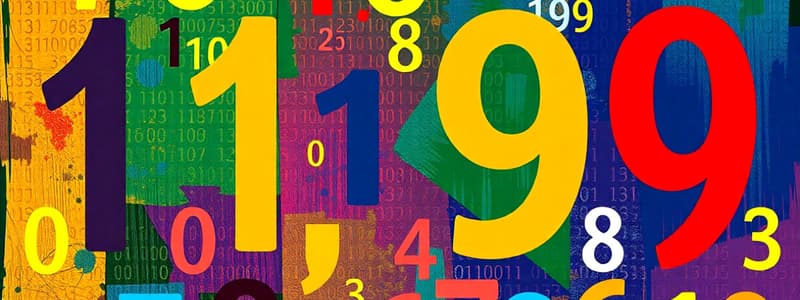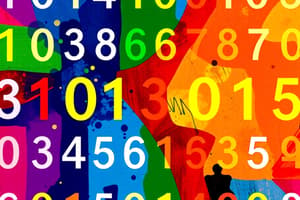Podcast
Questions and Answers
What is the decimal equivalent of the binary number 101101?
What is the decimal equivalent of the binary number 101101?
- 49
- 51
- 47
- 45 (correct)
Convert the binary number 1110001 to its decimal equivalent.
Convert the binary number 1110001 to its decimal equivalent.
- 115
- 111
- 117
- 113 (correct)
What decimal number does the binary number 0.0101 represent?
What decimal number does the binary number 0.0101 represent?
- 0.3125 (correct)
- 0.40625
- 0.375
- 0.250
Calculate the decimal value of the binary number 1101.01.
Calculate the decimal value of the binary number 1101.01.
Determine the decimal representation of the binary number 110010.101.
Determine the decimal representation of the binary number 110010.101.
Flashcards
Binary Number
Binary Number
Base-2 number system using 0 and 1.
Decimal Number
Decimal Number
Base-10 number system, the one we commonly use.
Binary to Decimal Conversion
Binary to Decimal Conversion
Assign powers of 2 to each digit from right to left, starting with 2^0.
Conversion Calculation
Conversion Calculation
Signup and view all the flashcards
2^0
2^0
Signup and view all the flashcards
Powers of 2
Powers of 2
Signup and view all the flashcards
Fractional Binary Conversion
Fractional Binary Conversion
Signup and view all the flashcards
2^-1
2^-1
Signup and view all the flashcards
Study Notes
Converting Binary to Decimal Numbers
- Binary numbers (base-2) convert to decimal numbers (base-10).
- Binary digits consist of 0 or 1.
Conversion Process
- Begin from the rightmost digit of the binary number.
- Assign powers of 2 to each digit, starting with 2^0 on the right, increasing to the left.
- Multiply each binary digit by its corresponding power of 2.
- Add the results of each multiplication.
- Ignore any terms with a binary digit of 0; focus on digits that are 1.
Examples
- 1010 (binary) = (1 * 2^3) + (0 * 2^2) + (1 * 2^1) + (0 * 2^0) = 8 + 0 + 2 + 0 = 10 (decimal).
- 10010 (binary) = (1 * 2^4) + (0 * 2^3) + (0 * 2^2) + (1 * 2^1) + (0 * 2^0) = 16 + 0 + 0 + 2 + 0 = 18 (decimal).
- Useful Powers of 2:
- 2^0 = 1
- 2^1 = 2
- 2^2 = 4
- 2^3 = 8
- 2^4 = 16
- 2^5 = 32
- 2^6 = 64
- 2^7 = 128
- 2^8 = 256
Example with Multiple 1s
- 11011 (binary) = (1 * 2^4) + (1 * 2^3) + (0 * 2^2) + (1 * 2^1) + (1 * 2^0) = 16 + 8 + 0 + 2 + 1 = 27 (decimal).
Practice Examples
- Example 1: 1100011 (binary)
- = (1 * 2^6) + (1 * 2^5) + (0 * 2^4) + (0 * 2^3) + (0 * 2^2) + (1 * 2^1) + (1 * 2^0)
- = 64 + 32 + 0 + 0 + 0 + 2 + 1 = 99 (decimal).
- Example 2: 01010110 (binary)
- = (0 * 2^7) + (1 * 2^6) + (0 * 2^5) + (1 * 2^4) + (0 * 2^3) + (1 * 2^2) + (1 * 2^1) + (0 * 2^0)
- = 0 + 64 + 0 + 16 + 0 + 4 + 2 + 0 = 86 (decimal).
Converting Fractional Binary Numbers
- For binary numbers that include a fractional part, digits to the right of the decimal point are assigned negative powers of 2, beginning with 2^-1.
- Use the same process as with whole binary numbers, but include the negative powers of 2.
Examples of Negative Powers of 2
- 2^-1 = 1/2
- 2^-2 = 1/4
- 2^-3 = 1/8
- 2^-4 = 1/16
- 2^-5 = 1/32
- 2^-6 = 1/64
- 2^-7 = 1/128
Fractional Binary Number Conversion Example
- 1100.101 (binary)
- = (1 * 2^3) + (1 * 2^2) + (0 * 2^1) + (0 * 2^0) + (1 * 2^-1) + (0 * 2^-2) + (1 * 2^-3)
- = 8 + 4 + 0 + 0 + (1/2) + 0 + (1/8)
- = 12 + 0.5 + 0.125 = 12.625 (decimal).
Another Fractional Binary Number Conversion Example
- 10011.011 (binary) = (1 * 2^4) + (0 * 2^3) + (0 * 2^2) + (1 * 2^1) + (1 * 2^0) + (0 * 2^-1) + (1 * 2^-2) + (1 * 2^-3)
- = 16 + 0 + 0 + 2 + 1 + 0 + (1/4) + (1/8)
- = 19 + 0.25 + 0.125 = 19.375 (decimal).
Studying That Suits You
Use AI to generate personalized quizzes and flashcards to suit your learning preferences.
Description
Learn how to convert binary numbers (base-2) to decimal numbers (base-10). Each binary digit is multiplied by powers of 2, starting from 2^0 on the right. The results are then added to obtain the decimal equivalent.




